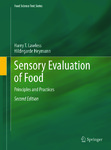Sensory Evaluation of Food
Abstract
The field of sensory science has grown exponentially since the publication of the previous
version of this work. Fifteen years ago the journal Food Quality and Preference
was fairly new. Now it holds an eminent position as a venue for research on sensory
test methods (among many other topics). Hundreds of articles relevant to sensory
testing have appeared in that and in other journals such as the Journal of Sensory
Studies. Knowledge of the intricate cellular processes in chemoreception, as well as
their genetic basis, has undergone nothing less than a revolution, culminating in the
award of the Nobel Prize to Buck and Axel in 2004 for their discovery of the olfactory
receptor gene super family. Advances in statistical methodology have accelerated as
well. Sensometrics meetings are now vigorous and well-attended annual events. Ideas
like Thurstonian modeling were not widely embraced 15 years ago, but now seem to
be part of the everyday thought process of many sensory scientists.
And yet, some things stay the same. Sensory testing will always involve human
participants. Humans are tough measuring instruments to work with. They come
with varying degrees of acumen, training, experiences, differing genetic equipment,
sensory capabilities, and of course, different preferences. Human foibles and their
associated error variance will continue to place a limitation on sensory tests and
actionable results. Reducing, controlling, partitioning, and explaining error variance
are all at the heart of good test methods and practices. Understanding the product–
person interface will always be the goal of sensory science. No amount of elaborate
statistical maneuvering will save a bad study or render the results somehow useful
and valid. Although methods continue to evolve, appreciation of the core principles
of the field is the key to effective application of sensory test methods.
The notion that one can write a book that is both comprehensive and suitable as
an introductory text was a daunting challenge for us. Some may say that we missed
the mark on this or that topic, that it was either too superficially treated or too in
depth for their students. Perhaps we have tried to do the impossible. Nonetheless the
demand for a comprehensive text that would serve as a resource for practitioners is
demonstrated by the success of the first edition. Its widespread adoption as a university
level text shows that many instructors felt that it could be used appropriately for
a first course in sensory evaluation.

